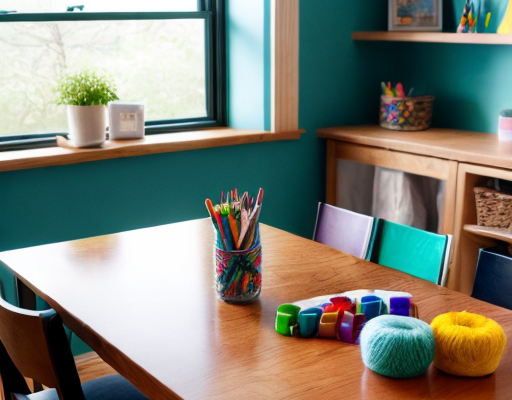
How to Set Up a Family Arts and Crafts Station for Rainy Days
“`html
Creating a Family Arts and Crafts Station for Rainy Days
When the skies turn grey and a pitter-patter sounds against your windows, there’s no better time to gather your family around and dive into a world of creativity. Setting up a family arts and crafts station for rainy days is not just a great way to pass the time; it can also encourage family bonding, spark imagination, and perhaps even uncover hidden talents. This comprehensive guide will help you create the perfect nook for all your artistic endeavors, ensuring that those rainy days are looked forward to with excitement and anticipation.
The Benefits of a Family Arts and Crafts Station
Before we delve into the nuts and bolts of setting up your arts and crafts station, let’s understand why it’s such a valuable addition to any home. Engaging in arts and crafts can significantly enhance a child’s motor skills and cognitive development. It also offers a therapeutic outlet for both children and adults, making it a perfect stress-relieving family activity.
Choosing the Right Space
The first step in creating an arts and crafts station is choosing an appropriate space. Look for an area that is well-lit, easily accessible, and can be made safe for all ages. It doesn’t have to be large; a corner of the living room or a spare table in the kitchen can serve the purpose wonderfully.
Furnishing Your Arts and Crafts Station
The key to a functional crafts station is having the right furniture. A sturdy table that can withstand the rigors of creative work and easy-to-clean chairs are essential. Consider using plastic coverings to protect surfaces and opt for storage solutions like rolling carts, bins, and shelves to keep supplies organized.
Stocking Essential Supplies
A well-stocked arts and crafts station will keep creative juices flowing without interruption. Essentials include paper, pencils, markers, crayons, various types of glue, scissors, and paint. You may also want to include a variety of textures like felt, foam, and fabric scraps to spark more tactile creativity.
Safe Crafting Practices
Safety should always be a top priority. Non-toxic, washable materials are a must, especially for younger children. Establish rules for using scissors and other sharp tools, and provide supervision to ensure everyone stays safe while having fun.
Organizing Your Station
A cluttered craft area can stifle creativity. Use clear containers to sort items by category and label them so everything is easy to find and put away. This also teaches children organization skills and the importance of taking care of their belongings.
Inspiration and Ideas
Keep a collection of craft books or a binder of printouts for those days when inspiration may be running low. A whiteboard or bulletin board to display potential project ideas or family art challenges can also help get the creative gears turning.
Encouraging Free Expression
While structure is important, allow room for free expression. Resist the urge to direct every project; instead let each family member explore their individual styles and preferences. This approach fosters creativity and confidence in their artistic abilities.
Including Educational Elements
Arts and crafts can be educational too. Incorporate elements of learning by using crafts to reinforce concepts from school, such as colors, shapes, letters, and numbers, particularly for younger children.
Upcycling and Recycling
Teach environmental responsibility by incorporating upcycled items. Cardboard tubes, egg cartons, and old magazines can be turned into incredible art projects. This not only stretches your supplies but also instills values about reducing waste.
Adapting for Different Ages
Family arts and crafts should be inclusive. Provide simpler craft options for younger children and more complex projects for older ones. This way, every member of the family can participate at their own level.
Hosting Family Craft Nights
Turn crafting into a beloved family tradition with regular craft nights. Theme these evenings around holidays, seasons, or family events to make them extra special and give everyone something to look forward to.
Documenting Your Creations
Don’t forget to document your artistic journey! Take pictures of finished projects and consider displaying chosen works in a dedicated area. Creating a scrapbook or photo album of craft projects is also a great keepsake.
Setting a Budget for Your Craft Station
Arts and crafts can be an expensive hobby if not managed wisely. Set a budget for supplies and stick to it. Look for sales, use coupons, and buy in bulk when possible. Also, always take stock of what you have before buying new materials to prevent duplicate purchases.
Cleaning Up and Maintenance
To ensure that your craft station remains a pleasant and inviting space, clean up after each crafting session. Make it a family routine to put things back in their place and perform regular maintenance, such as sharpening pencils and restocking paper.
Exploring Arts and Crafts Communities
Finally, consider connecting with online and local arts and crafts communities. Platforms like Pinterest and Instagram offer a wealth of ideas, and local workshops or craft fairs can provide inspiration and opportunities to learn new techniques.
Crafting isn’t just about making things—it’s about making memories. With your family arts and crafts station ready, rainy days will transform into a canvas of possibilities. Enjoy the process, cherish the mess, and don’t forget to celebrate every masterpiece, big or small.
“`

